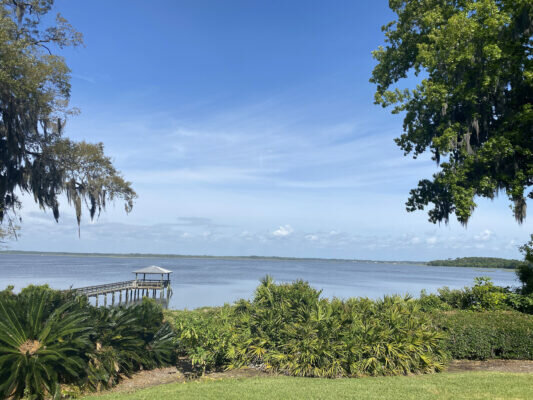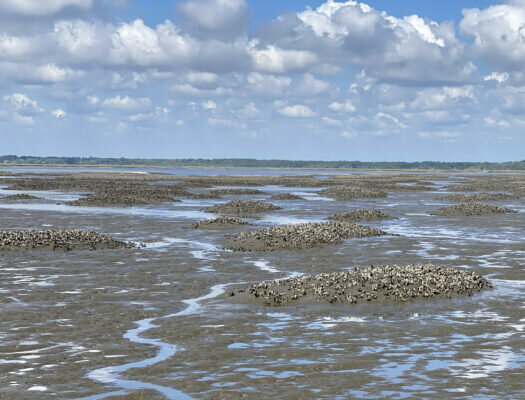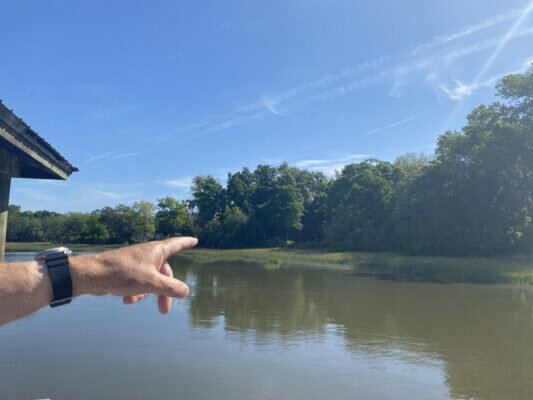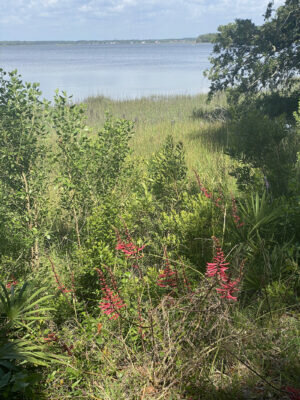Pat’s Wildways: Amelia Flats
By Pat Foster-Turley
I had never heard of Amelia Flats until Jeff Kennard started sending me emails many moons ago when he was the first person who reported a lone female wild turkey around the area of Amelia Baptist Church. Since then he has sent me various writings of his, describing in beautiful detail the wildlife he sees on Amelia Flats. But where is Amelia Flats anyway, I wondered?
 The shoreline is currently occupied by long-term residents on large lots like this one facing Amelia Flats.
The shoreline is currently occupied by long-term residents on large lots like this one facing Amelia Flats.Well, now I’ve seen it for myself. Amelia Flats is a long-ago name for an area of oyster beds and mudflats bordering the west side of Amelia Island from the Kraft Athletic Club to “the Point,” where Gerbing Road meets the river. Amelia City is the name of this part of Amelia Island, the middle part, where past generations built their homes far away from the hubbub of the town of Fernandina. Some long-term residents, like Bucko and I, still remember the Sandbar Restaurant at the Point. And other residents with a few generations of Amelia Island ancestors behind them still live there.
Recently, I had the occasion to see Amelia Flats for myself, but not under happy circumstances. I visited two homeowners, the Kennards and the Olivers, who have homes bordering this tidal mudflat. Both families have deep roots in Florida and on Amelia Island in particular. At high tide, the view looks out over the river, like a giant lake with boats in the distance traversing the Intracoastal Waterway. As the tide falls, many herons and egrets come here to feed on the rich marine life. At low tide, it is clear that this area is full of oyster beds, a bigger patch than I’ve seen anywhere around here.
 The large expanse of oyster beds of Amelia Flats was enhanced by Gus Gerbing back in the 1920s.
The large expanse of oyster beds of Amelia Flats was enhanced by Gus Gerbing back in the 1920s.These oysters have a long history, too. In the 1920s Gus Gerbing, a Renaissance man of his time, started an oyster farm on his mudflat property here, sold oysters, and opened the Sandbar Restaurant. When the paper mills came to town in the 1930s, the water became too contaminated to raise oysters. Environmental protections clicked in later, but the oysters were mostly gone. Now, with years of clean water, the oysters are thriving again. They are not legally harvested but provide water cleansing services, erosion protection, and a substrate for many smaller critters that wading birds of all types come in to feed on.
Gus Gerbing also built the amazing attraction of Gerbing Gardens on his acres of Amelia City land. Over the years, he cultivated and developed many varieties of azaleas and camellias, some named after him. The Olivers knew the Gerbings and acquired some of these rare shrubs that are still thriving in their yard today. Although the Gerbing Gardens no longer exist, there are still homes built on half-acre or more lots, with plenty of habitat remaining for native animals to call home themselves. County ordinances with R-1 zoning have been long in place to ensure that this neighborhood character remains.
 Now, the area being pointed to, in current R-1 zoning, is being threatened by a change to a Planned Unit Development that will destroy this area.
Now, the area being pointed to, in current R-1 zoning, is being threatened by a change to a Planned Unit Development that will destroy this area.But now, this neighborhood is under threat like many others on Amelia Island. The Amelia Baptist Church has revealed plans to build two four-story condominium towers with 24 units, a swimming pool, a viewing platform on the shore, parking lots, and all the paved roads and traffic that goes along with it. Water from this development will eventually make its way to the oyster beds in the mudflat, potentially harming them, and the congestion and activity will not be well received by the wading birds that routinely forage here.
 Coral bean plant flowers along the shore where a condominium is being proposed.
Coral bean plant flowers along the shore where a condominium is being proposed.The traffic from this proposed development will be routed along now unpaved Shadow Woods Lane, where old long-time residents in four homes have enjoyed peace and quiet until now. But if these plans go through, this road will be paved and full of traffic emptying on Buccaneer Trail, a proclaimed canopy road. Towering Spanish moss-draped live oak trees frame this road, but it is used by many as a shortcut that bypasses Amelia Island Parkway on the way south. It’s gotten busier and busier in the years we have lived here and accidents are common. If this condominium project goes through, the road will be intolerably worse. So what? Cut down the live oaks and make it wider, some say.
No way! Zoning R-1 should be able to stop this proposed condominium project in its tracks. But wait? The church and the developer are working to change the zoning to a Planned Unit Development to enable this condominium project. The county is known for making zoning changes that encourage more crowded development. Will this old neighborhood be next? This must be stopped.
Pat Foster-Turley, Ph.D., is a zoologist on Amelia Island. She welcomes your nature questions and observations. [email protected]






Comments
No comments on this item Please log in to comment by clicking here